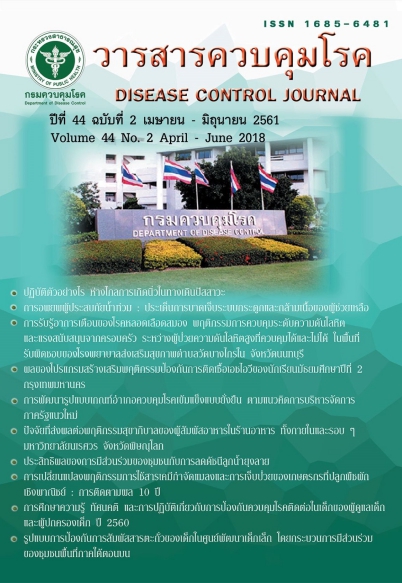Flood victim evacuation: issue of musculoskeletal injuries of the helpers
DOI:
https://doi.org/10.14456/dcj.2018.12Abstract
Flood victim evacuation is an important procedure in the emergency life-saving responses. Even though there are many portable devices and equipment to transfer flood victims during flood situation, the usage of equipment is limited by out of control situation, such as water level, rough ground, narrow space, etc. Therefore, helpers always use forceful exertion to lift and move flood victims. This article was aimed to present the reviewed risk information of the helpers to musculoskeletal injuries (MSI) to raise awareness and perception of risks in flood evacuation. Referring to the literature review, it was found that forceful exertion of helpers was the most common method to move victims during flood evacuation (72.30%) in Thailand. Prevalence of MSI of helpers was more than 60.00%, especially low back pain. It was also found that postures of one, two, and three helpers to move victims by forceful exertion were high risk to MSI. The percentage was showed 63.10%, 42.80% and 63.60%, respectively. In addition, a reported experiment study concerning with victims transfer in the United States indicated that average lumbar flexion more than 50 degrees led to compressive force on the L5-S1 disc over threshold limit value. This lifting task is the major activity contributing to the risk of muscle fatigue and lower back injury. The reviewed studies indicated that moving flood victims by forceful exertion postures can cause risk to MSI. Therefore, team leader and helpers should use the suitable flood evacuation procedures concerning with health and safety. They should be trained the skill and safety procedures for transferring victims, system of lifting team, communication between helpers and victims, and selecting the proper equipment. Besides, physical fitness test should be performed for helpers. In conclusion, the ergonomics for flood evacuation is not only important for health and safety of victims, but also for health and safety of helpers.
Downloads
References
2. วีรบูลณ์ วิสารทสกุล. การปรับตัวและการช่วยเหลือจากภาคส่วนต่าง ๆ ในยามภัยพิบัติ. วารสารสำนักบัณฑิตอาสาสมัคร มหาวิทยาลัยธรรมศาสตร์ 2555;8:133-48.
3. World Health Organization. Risk reduction and emergency preparedness: WHO six-year strategy for the health sector and community capacity. Geneva: World Health Organization; 2014.
4. กรมป้องกันและบรรเทาสาธารณภัย. แผนป้องกันและบรรเทาสาธารณภัยแห่งชาติ พ.ศ. 2553-2557. กรุงเทพมหานคร: กรมป้องกันและบรรเทาสาธารณภัย; 2555.
5. Kee D, Karwowski W. A comparison of three observational techniques for assessing postural loads in industry. Int J Occup Saf Ergon 2007;13:3-14.
6. Dempsey PG. A critical review of biomechanical, epidemiological, physiological and psychophysical criteria for designing manual materials handling tasks. Ergonomics 1998;41:73-88.
7. Sterud T, Ekeberg Ø, Hem E. Health status in the ambulance services: a systematic review. BMC Health Serv Res 2006;6:82.
8. The National Institute for Occupational Safety and Health. Emergency medical services workers [Internet]. 2016 [cited 2015 Aug 6]. Available from: www.cdc.gov/niosh/topics/ems
9. Adib-Hajbaghery M, Zohrehea J. Back pain among paramedics: a pilot study. Nurs Midwifery Stud 2013;2:103-4.
10. Lairet J, King J, Vojta L, Beninati W. Short-term outcomes of US Air Force Critical Care Air Transport Team (CCATT) patients evacuated from a combat setting. Prehospital emergency care 2013;17:486-90.
11. Maguire BJ, Smith S. Injuries and fatalities among emergency medical technicians and paramedics in the United States. Prehosp Disaster Med 2013;28:376-82.
12. Kaewdok T, Taptagaporn S, Kooncumchoo P, Charoenporn N, Piriyaprasarth P. Video-based postural hazard identification during flood victim evacuation. Thammasat International Journal of Science and Technology 2016;21:29-37.
13. Marras WS, Davis KG, Kirking BC, Bertsche PK. A comprehensive analysis of low-back disorder risk and spinal loading during the transferring and repositioning of patients using different techniques. Ergonomics 1999;42:904-26.
14. Jang R, Karwowski W, Quesada PM, Rodrick D, Sherehiy B, Cronin SN, et al. Biomechanical evaluation of nursing tasks in a hospital setting. Ergonomics 2007;50:1835-55.
15. Vieira E, Kumar S. Safety analysis of patient transfers and handling tasks. Qual Saf Health Care. 2009;18:380-4.
16. National Institute for Occupational Safety and Health. Work practices guideline for manual lifting. Cincinnati: National Institute for Occupational Safety and Health; 1981.
17. Waters TR. When is it safe to manually lift a patient?. Am J Nurs 2007;107:53-8.
18. Zhuang Z, Stobbe TJ, Collins JW, Hsiao H, Hobbs GR. Psychophysical assessment of assistive devices for transferring patients/residents. Appl Ergon 2000;31:35-44.
19. Roffey DM, Wai EK, Bishop P, Kwon BK, Dagenais S. Causal assessment of workplace manual handling or assisting patients and low back pain: results of a systematic review. Spine J 2010;10:639-51.
20. Marras WS, Karwowski W. Intervention, control and application in occupational ergonomics. 2nd ed. New York: Taylor and Francis; 2006.
21. Kjellberg K, Lagerstrom M, Hagberg M. Patient safety and comfort during transfers in relation to nurses’ work technique. J Adv Nurs 2004;47:251-9.
22. Caspi CE, Dennerlein JT, Kenwood C, Stoddard AM, Hopcia K, Hashimoto D, et al. Results of a pilot intervention to improve health and safety for health care workers. J Occup Environ Med 2013;55:1449-55.
Downloads
Published
How to Cite
Issue
Section
License
Articles published in the Disease Control Journal are considered as academic work, research or analysis of the personal opinion of the authors, not the opinion of the Thailand Department of Disease Control or editorial team. The authors must be responsible for their articles.






